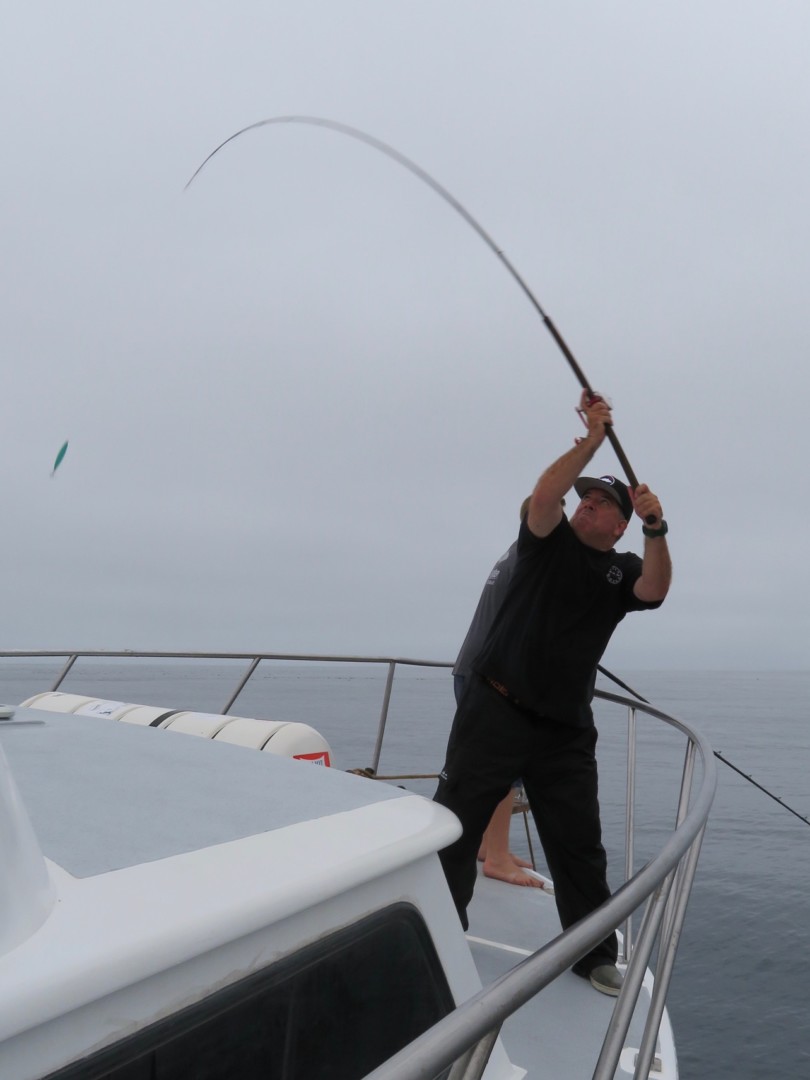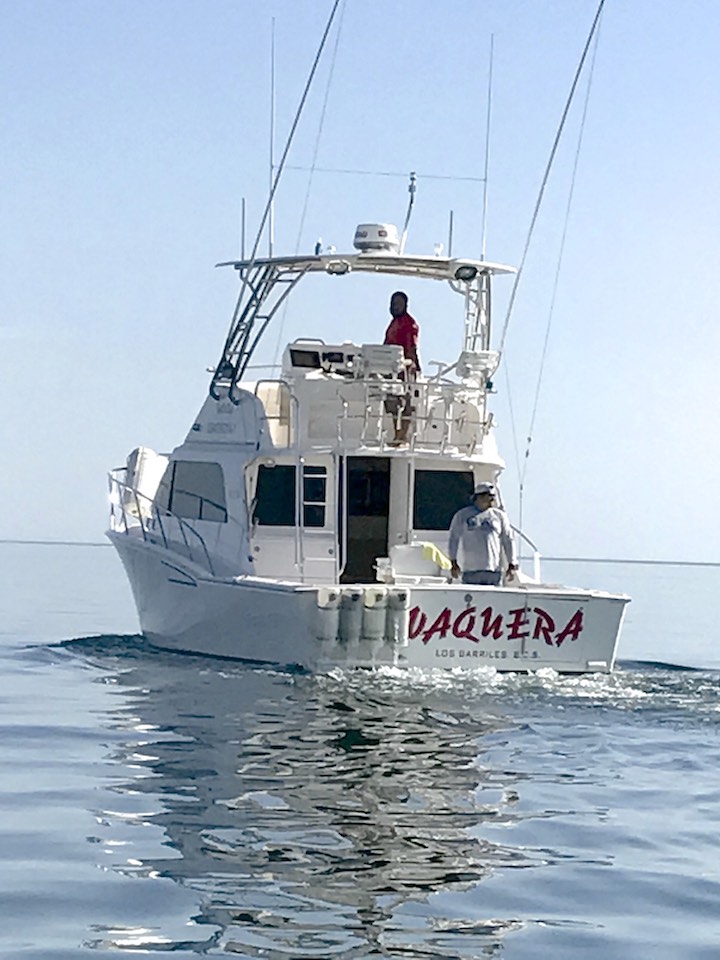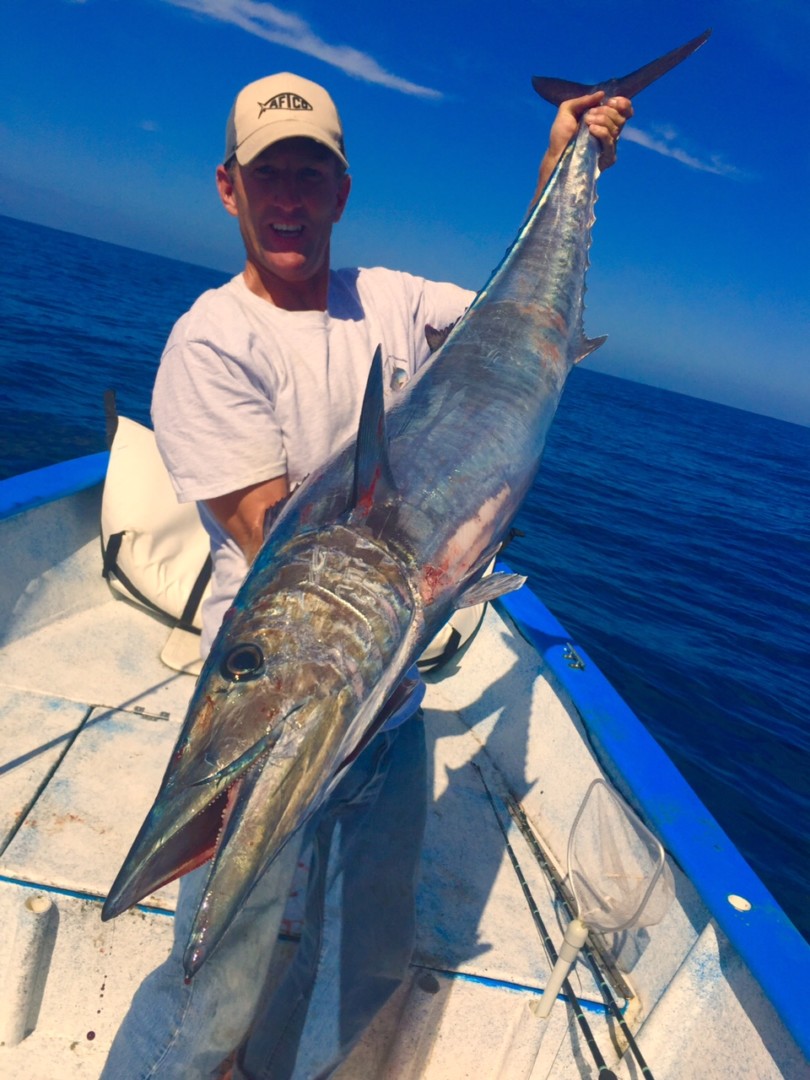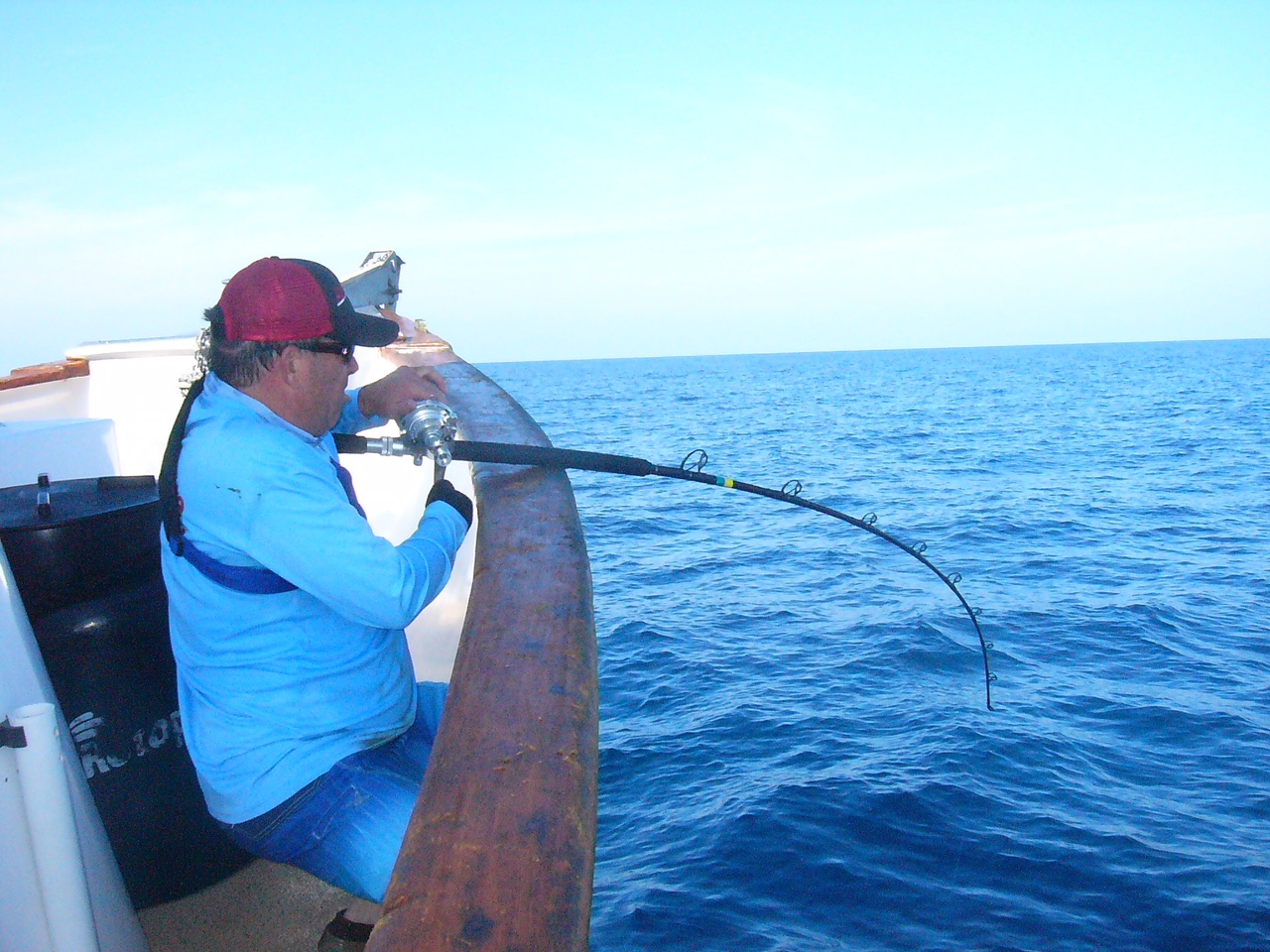A Time for the Long Rod

Here on the west coast we have a technique for casting poppers or surface iron to fish that are either finning, foaming on bait balls, or actively chasing bait on the surface. The key is to cast longer distances to these fish without spooking them with the boat. We do this by using 8 to 9 foot cork taped rod with a 500/600 size reel attached with a reel clamp with 65 to 80 lb braided line when targeting bigger Bluefin tuna, Yellowtails, and Yellowfin tuna. There are still a few guys that will use the mono because they say the braid is hard to cast and mono flows better off the reel. Fishing with mono for Yellowtail would be a little more common, but casting at 80 to 200 lb Bluefins, the braid definitely outweighs any negatives. The key to casting braid efficiently on the long rods is tying a very compact knot and using a very short leader(24 to 36″) so you never cast the knot through the guides. If the knot hits one of the smaller guides on the way out huge backlashes result sometimes taking your outfit out of commission. Knots we use include the Pena knot, improved Albright, and FG knot for maximum castibility and guide clearance. You can also use dental floss with half hitches to get rid of any real flat spots on knot that might catch on guide. It will let you taper the knot on both sides so it flows in and out of the guides with ease. (To reiterate, some anglers use a leader length as long as the fish they are targeting. Small clean knots are key if the knot is passing through the guides.)

Rod actions we use are usually medium fast to fast tip(first 24 to 30″ of rod) to cast the lure with a slow medium heavy power mid section that shuts down where the handle starts. The bend of a rod should fit your actual physical condition. If you are a big guy that weighs a couple hundred pounds, in good shape you will be able to handle a heavy power rod. We believe the more a rod bends the better off we are as an angler. Remember the more rod in your possession that is not bending the more pressure on you which over time equals pain. The more the rod is bending towards the fish the more pressure on the fish. You can have a rod that bends too much which is commonly called “bottoming out”. This a stale mate in that you will not be able to lift the fish and it’s just hanging onto dead weight until the fish dies.
There are a lot of anglers that follow the IGFA standards but when fishing the long rod for bigger fish like tuna the first thing you realize is the rail is your friend. With the IGFA standards you are unable to rest your rod on the rail once the battle begins. There is no belt and harness usually so the IGFA standards will not apply.

Once you get the long cast in the right area of fish some of the bites are amazing explosions, and you are instantly pinned in place. These gamefish tend to give you one really good run, then continue to move around until they settle into the fight. With the long rod, know your drag setting, so when they start doing their little “rodeo show”(erratic changes of direction) I often point the rod at the fish. In fishing 101 this is a big no-no but when you try to put a 8 or 9′ rod in your gut, or a rod belt, it gets pretty heavy right from the start. Either way you decided to do it, once the fish starts moving deeper, straight down in the water column, we start putting the rod on the rail.

If you are familiar with the theory of a Fulcrum and lever this is an excellent example of it. The rail will be the fulcrum and the rod the lever. Most important thing for any angler is to keep the rod bent at all costs to keep constant steady pressure on the fish. A couple of ways to effectively move the fish is to put the rod under your left arm if you are right-handed and pull down on the butt of the rod with your arm to load rod them slowly come up cranking without taking the bend out of your rod tip so you can gain line. This is the most common way most anglers do it and if you are in a skiff you will be on one knee doing this since the rails will be shorter. IF you are in a bigger boat it will be much easier. The other way I see guys do this is sticking the rod between their legs and sitting on it. This works but you will not be able to react if the fish decides to change direction and take you down the rail as well as being pretty uncomfortable.
The long rod helps anglers keep their line clear of the hull on the boat when you get a sizable fish in the death spiral under the boat. This is critical when you are fishing a shorter rod that is loaded with the weight and power of the fish as he changes direction. The ability to react with a squirrelly fish is very important. Once your line hits the bottom of the boat the percentage of failure increases exponentially as you either loose the fish or weaken the line enough that the fish can break it on a straight pull at a higher drag. The other thing a long rod offers is the ability to use the rod to clear the bottom of the boat as the fish changes direction. The extra 2 to 3 feet of the rod works wonders as you put the tip in the water and start your run to clear the corner as you follow the fish. The bottom of the boat as mentioned before can be very abrasive on your braid depending on its condition, and it doesn’t take much to break it.

For casting maximum distance the long rod gives you a big advantage with its length and the ability of a pendulum cast will help. The best thing to do is practice casting a long rod is get the feel of the rod and work at educating your thumb to regulate the spool speed. Casting into foaming fish and getting a backlash will be one of the worst things you will ever experience holding on to your rod for dear life waiting for the line to break. No Fun. Spend some time in a park, or at the harbor, even breakwater to perfect your cast. Prior planning prevents poor performance and the fish of a lifetime is right at the end of a good, long cast.
 Spinning rods are frequently used back east for popper fishing and an 8 foot rod is definitely a dream to cast, it’s when you hook the fish that things get interesting. Aftco does make a spinning rod harness to go with their rod belts that works for the stand up guys fishing the spinning reels. Depending on the rod action and power things can get really interesting pulling on a big fish with a spinning rod even with the harness. We have a lot of respect for the Northeast guys pulling on borderline/ legit giants with spinning gear. It takes a strong back and plenty of stamina to make this interaction a potential success with the end result being a fish in the box. Remember you cannot go to the rail with a spinning rod so all the pressure is on you.
Spinning rods are frequently used back east for popper fishing and an 8 foot rod is definitely a dream to cast, it’s when you hook the fish that things get interesting. Aftco does make a spinning rod harness to go with their rod belts that works for the stand up guys fishing the spinning reels. Depending on the rod action and power things can get really interesting pulling on a big fish with a spinning rod even with the harness. We have a lot of respect for the Northeast guys pulling on borderline/ legit giants with spinning gear. It takes a strong back and plenty of stamina to make this interaction a potential success with the end result being a fish in the box. Remember you cannot go to the rail with a spinning rod so all the pressure is on you.
No matter what type of fishing you do remember there is specific tackle that will make your experience more rewarding helping you land targeted gamefish. By researching your targeted species, the feeding modes they are in, and their location plus any other factors like tides and moon phase, your percentages of success will increase. Know the tackle that will best fit your applications and make sure all the little things are done correct. Good line, reel that is functioning correct, check your guides for chips, sharpen your hooks, and cinch your knots with a knot puller. The prior planning increases your landing rate.
Some of the more popular long rods being used On the west coast include: CalStar 540H, Seeker Ulua93H, Seeker 6480H, Cousins CJB80XHS, Cousins F90J-CT or GG 95J-MAG, IROD Kaimana SWK 805, Daiwa PRT80HF and Fishing Syndicate Jig sticks are worth a look. Rods are like golf clubs, tennis racquets, and any other sporting equipment that needs to feel right in your hand. Find the one that fits your needs but most importantly feels comfortable when its bent in your hands. As they say in fishing, the rod is an extension of your arm so make sure it feels the way you want it to.
Hoping all your lines are tights ones.
Team Accurate
 Custom Color Reels
Custom Color Reels










